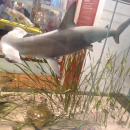Project: Big Shark, Big Loss, Big Impact: Sharks are Apex Predators
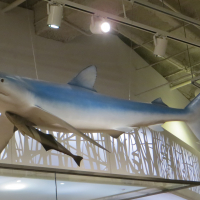
Play two predator-prey simulations with your students to learn why apex predators like sharks are necessary for functioning, healthy ecosystems.
Produced in partnership with the Biodiversity Education and Awareness Network and the Ontario Ministry of Natural Resources


Students are fascinated by dangerous sharks, but may not realize the key role they play in marine ecosystems. Large predatory fish populations have plummeted over 90% in the last decade. This decline has the potential for serious and cascading effects on Canada’s marine ecosystems. Through two simulation games, students will learn why apex predators are necessary for functioning ecosystems.
Learning Goals
- Analyse positive and negative impacts of humans hunting sharks within marine communities
- Describe energy transfer in a food chain and explain the effects of the elimination of apex predators
- Collect data by conducting an experiment to do with the environment and record observations
- Read, interpret, and draw conclusions from data presented in charts, tables, and graphs
Background Information
Canada’s three oceans, Atlantic, Pacific and Arctic, are home to 41 species of sharks including the Shortfin Mako, Greenland, Sleeper, Basking, Smooth Hammerhead, and even the Great white shark! Sharks often fill the role of “apex” or top predators in their ecosystems because of their large size and few natural predators. As apex predators, sharks feed on animals below them in the food web, and help regulate and maintain the balance of marine ecosystems. Most sharks have diverse diets and switch prey species when certain populations are low. By switching to more abundant prey, they allow low populations to rebound and prevent abundant species from monopolizing a limited resource. Others scavenge the sea floor to feed on dead carcasses. Apex predators also influence spatial distribution of prey species through intimidation and keep them from overgrazing certain habitats.
The unfortunate reality of course is that humans are the ocean’s true apex predators, killing more than 100 million sharks each year. Fishing has reduced many large predatory shark populations worldwide by 90% over the past century. Sharks now represent the largest group of threatened marine species on the International Union for Conservation of Nature’s (IUCN) Red List of threatened species, yet only three of the 350 shark species (Basking, Whale and White), are protected from the pressures of international trade. The remaining species are ignored or seen as low priorities despite their vulnerability to overfishing and their important role in their ecosystems. In Canada there are ten species of sharks designated at risk by the Committee on the Status of Endangered Wildlife in Canada (COSEWIC). These include White, Brown Cat, Tope, Bluntnose Sixgill, Blue, Basking, Porbeagle, Spiny dogfish, Shortfin Mako, and Spotted Spiny Dogfish.
Some fisheries directly target sharks as their intended catch, but other fisheries accidentally capture sharks as “bycatch”, a term used for unintended catch. These unwanted sharks are thrown overboard, often dead or injured. It is estimated that tens of millions of sharks are caught as bycatch each year, which is nearly half of the total shark catch worldwide.
Between 26 and 73 million sharks are killed annually for their fins globally (caught both specifically and as bycatch). Once a delicacy and sign of prestige in Asian cultures, shark fin soup consumption is on the rise. A single bowl of soup can cost up to $100 making the fins the most commercially valuable part of a shark. Since the rest of the shark is less valuable and bulky, the fins are removed and the carcasses thrown overboard. This practice, known as “shark finning,” only uses between one and five percent of the shark. Shark finning is prohibited in Canadian waters since 1994.
In December 2011, Canadian MP Fin Donnelly introduced a private member’s bill that would ban the import of shark fins into Canada. Canada imports around 77 000 kilograms of fins each year. The practise of shark finning is already illegal in Canadian waters, but there is no law to prevent importation. If the ban is implemented, those in violation could face jail time or a fine of up to $100 000. Some Ontario municipalities have already taken steps in this direction – Toronto, Oakville, and Brantford have already banned the sale of shark fins. The bill was defeated in 2013 by a vote of 138 for and 143 against.
The overfishing of apex predators can lead to serious consequences for many other ocean species, in ripples called “cascades”. Comparisons of areas with and without apex predators have shown that apex predators maintain greater biodiversity and higher densities of individuals, while areas without apex predators experience species absences. Without apex predators there is the potential for unchecked predation by lower predatory species and overgrazing of vegetation by herbivorous prey species.
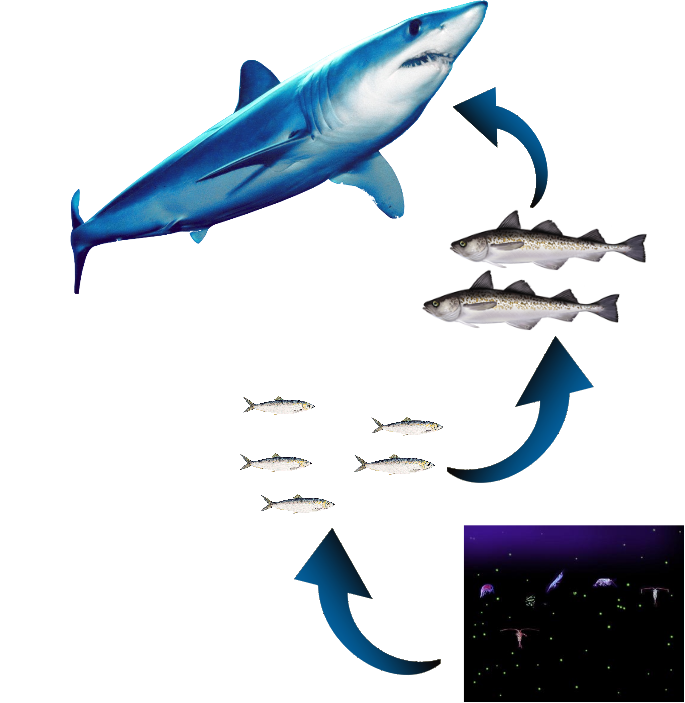 The following is a simplified Atlantic food web: Shortfin Mako sharks are apex predators and eat Bluefish (known in Canada as Pollock). Bluefish are medium sized piscivores weighing as much as 18 kg. They eat smaller fish like Atlantic Herring. Herring are small forage fish that eat plankton.
The following is a simplified Atlantic food web: Shortfin Mako sharks are apex predators and eat Bluefish (known in Canada as Pollock). Bluefish are medium sized piscivores weighing as much as 18 kg. They eat smaller fish like Atlantic Herring. Herring are small forage fish that eat plankton.
Reproductive rates vary widely between these different fish species. Shortfin Mako sharks bear between 4 and 18 young once every 3 years. Bluefish spawn once a year with females producing about one million eggs per year. Atlantic Herring can spawn from April to November in Canadian waters. A fully mature female can produce upwards of 260 000 eggs at a time.
Materials
- 100 tokens to represent plankton (plastic poker chips, small pieces of construction paper etc)
- 5 arm bands (or smocks etc) in one colour
- 2 arm bands (or smocks) in a second colour
- 2 arm bands (or smocks) in a third colour
- Data tables for simulation 1 [Google Doc]
Preparation
Discuss sharks as apex predators in marine ecosystems. The first simulation will represent an ecosystem where apex predators are present and human activities are absent.
Scatter 100 plankton tokens on the ground in the designated play area. This represents the food for the herring.
Instructions
Step 1
Human Activities are Absent
Select ~15 students to play the role of herring. Record this number in the data table for round 1. They must collect their food – plankton, and avoid being eaten by Bluefish. If tagged they must give the Bluefish their plankton cards and go to an area designated as the fish cemetery.
Select ~5 students to play the role of Bluefish and give each a matching armband. Record the number of Bluefish in the data table for round 1. They must hunt their food – herring, by tagging herring and taking their plankton cards. Bluefish must avoid being eaten by Shortfin Mako sharks. If tagged they must give the sharks their plankton cards and go to an area designated as the fish cemetery.
Select ~ 2 students to play the role of Shortfin Mako sharks and give each a matching armband. Record the number of sharks in the data table for round 1 . They must hunt their food – Bluefish, by tagging Bluefish and taking their plankton cards. As apex predators they have no predators
Step 2
Reinforce the rules to prevent the game from getting rough and outline consequences for improper behaviour.
The simulation only takes about 45 seconds. Release the herring, followed by the Bluefish, followed by the sharks with 5 seconds between each group’s release.
Step 3
After 45 seconds, have your students rejoin you (living and dead). Any fish that does not have a plankton card in its hands has died of starvation.
If both sharks died of starvation, replace them with one new shark (student from the fish cemetery) because the shark moved into the area because there was no competition.
Step 4
Each survivor now has the potential to reproduce. In this simulation, herring spawn twice a year and Bluefish spawn once a year Alternating between two surviving herring and one surviving Bluefish (i.e. two herring reproduce, one Bluefish reproduces, two herring reproduce, one Bluefish reproduces etc), each living fish chooses one person from the fish cemetery to become a baby of the same species as the person who selected him/her. After all herring and Bluefish have reproduced, any living sharks will reproduce by selecting a baby from the fish cemetery.
There will probably not be enough students in the fish cemetery for everyone to reproduce; start by alternating herring and Bluefish until you run out of students.
Count the new population of living herring, Bluefish, and sharks and record it on the data table for round 2.
Step 5
Play round two following the same rules as before. Collect the plankton cards from the students and scatter them on the ground again. Release the students and after 45 seconds of game play allow the survivors to reproduce and record the new populations on the data table.
Play the game for at least three additional rounds, recording the population numbers on the data table.
Step 6
Human Activities are Present
Introduce two hunters who hunt sharks. The hunters wear the third coloured armbands and tag sharks. If any sharks die of starvation in this new environment, they will not be replaced because there are not enough sharks remaining in the ocean to move in and replace those that have been hunted.
Play at least five rounds and record the numbers on the data table.
Follow-Up
Gather the students and reflect on what happened.
- How were the two versions of this game the same?
- How were they different?
- What happened to the food chain when the apex predators were removed?
Have students create a series of graphs (bar, line etc) showing how prey populations changed in response to changes in predator populations. Exactly how the graphs are presented will depend on the level of your class. Below is one suggestion.
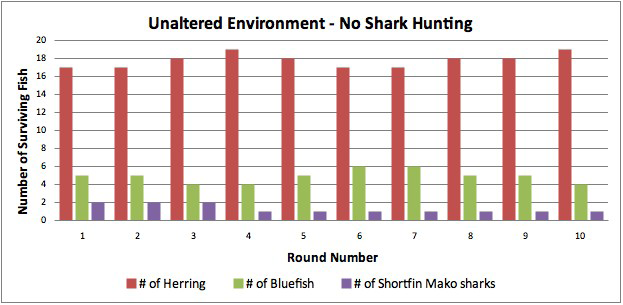
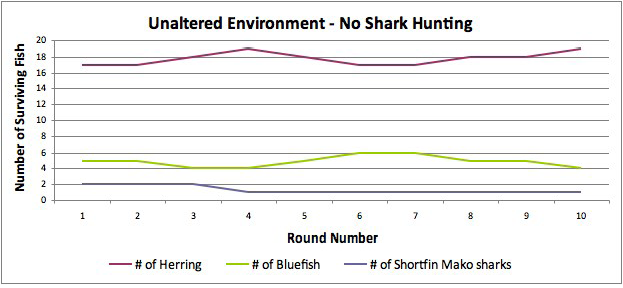
Graph #1 – Use a triple line graph or triple bar graph to show how many Herring, Bluefish, and Shortfin Mako sharks were alive at the beginning of each round before shark hunting was allowed. Place the round number on the x-axis and the number of Herring, Bluefish, and Shortfin Mako sharks on the y-axis.
Graph #2 – Use a triple line graph or triple bar graph to show how many Herring, Bluefish, and Shortfin Mako sharks were alive at the beginning of each round after shark hunting was allowed. Place the round number on the x-axis and the number of Herring, Bluefish, and Shortfin Mako sharks on the y-axis.
After graphing the data, have students interpret and draw conclusions from the data.
- What consequences did shark removal have on the fish populations?
- Did all populations behave the same way?
- Why did some populations drop while others grew larger?
Extension Activities
Do the companion activity: Big Shark, Big Loss, Big Impact: Sharks Change Prey Behaviour



